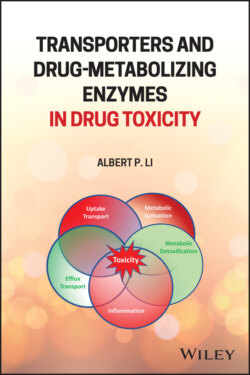Читать книгу Transporters and Drug-Metabolizing Enzymes in Drug Toxicity - Albert P. Li - Страница 15
1.3 The Multiple Determinant Hypothesis for Idiosyncratic Drug Toxicity
ОглавлениеA perplexing observation in drug toxicity is the phenomenon of idiosyncratic drug toxicity which occurs at an incidence of less than 1 per 5000 patient‐years, thereby cannot be detected with conventional regulatory clinical trials but would be clearly identified after marketing of a drug with a large patient population being exposed (1–5). To explain this phenomenon and to provide a possible mitigating strategy, I have proposed the multiple determinant hypothesis (3) which states that idiosyncratic drug toxicity occurs due to a confluence of multiple discrete events in the individual succumbing to drug toxicity (Figure 1.1).
Figure 1.1 Schematic illustration of the Multiple Determinant Hypothesis of Idiosyncratic Drug Toxicity. Each circle represents a key determinant due to genetic and/or environmental factors. The hypothetical situation shown here is the confluence of the five determinants leading to severe liver toxicity in a patient at the time of drug administration: 1. Increased transporter‐mediated uptake, leading to increased liver drug concentration. 2. Increased metabolic activation due to the co‐exposure to enzyme inducers, leading to higher rate of formation of toxic/reactive metabolites. 3. Compromises metabolic detoxification due to co‐exposure to GSH depleting agents and/or inhibitors of phase 2 conjugating pathways. 4. Sensitized inflammatory response due to diseases or exposure to sensitizing agents. 5. Compromised efflux of bile salt due to genetic polymorphism of BSEP or co‐exposure to BSEP inhibitors.
I would like to illustrate the role of drug transport and metabolism in the manifestation of idiosyncratic drug toxicity based on the Multiple Determinant Hypothesis.
This hypothetical drug, T, is a substrate of an uptake transporter. Upon uptake into the hepatocytes, T is metabolized to a reactive metabolite, T*. T* is the ultimate toxicant which reacts with key cellular proteins, leading to cell death. T* also can form protein conjugates, leading to the formation of a neoantigen which would elicit a cytotoxic inflammatory event, leading to liver failure. However, T also undergoes metabolic clearance via glucuronidation and sulfation, with the conjugates excreted via transporter‐mediated efflux. T* can be detoxified via glutathione S‐transferase (GST)‐mediated glutathione (GSH) conjugation.
The following are key determinants and the respective probability (p) in the patient population for the manifestation of liver toxicity, resulting in liver failure:
1 Determinant 1 (p1): Elevated uptake transporter activity, leading to higher than normal intracellular concentration.
2 Determinant 2 (p2): Elevated drug metabolizing enzyme activity due to prior exposure to inducers or genetic polymorphism, resulting in higher than normal T* formation.
3 Determinant 3 (p3): Suppressed UDP‐glucuronosyltransferase (UGT) and sulfotransferase (SULT) detoxification activity.
4 Determinant 4 (p4): Suppressed GST activity and/or reduced cellular GSH level.
5 Determinant 5 (p5): Hypersensitized inflammatory reactions due to previous exposure to the same drug and the associated neoantigen.
6 Determinant 6 (p6): Reduced efflux transporter activity of glucuronide and sulfate conjugates, leading to feedback inhibition of the detoxifying pathways.
In this hypothetical example, Determinant 2 (metabolic activation) is the most crucial, while the other determinants would exacerbate the hepatotoxic events. The patient who will succumb to liver failure is one with the confluence of risk factors – simultaneous occurrence of the various determinants of drug toxicity at the time of drug administration (Figure 1.1).
Based on the theory that co‐occurrence of multiple determinants are required for the manifestation of severe drug‐induced liver injuries (DILIs), the incidence of DILI in the patient population will be a product of the incidence of patients with each of the determinants at the time of drug administration as shown in the following equation:
Considering a hypothetical case that the co‐occurrence of four determinants is required for DILI, and that each determinant has an incidence of 10% of the patient population, I(DILI) will be 10% × 10% × 10% × 10% or 1 in 10 000 patients. This event therefore cannot be readily detected in the regulatory clinical trials due to the limited number of patients, but will be manifested when the drug is administered to the general patient population upon marketing.
